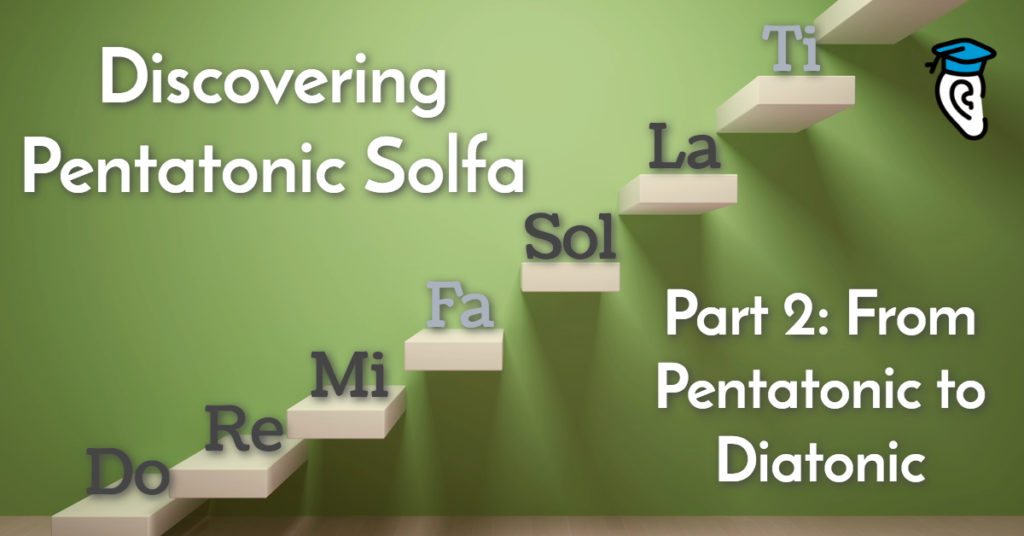Do you want to really hear music, and play what you hear on your instrument? The magic syllables of solfa (aka solfége, solfeggio) tell us not only what the notes are, but also how they relate to each other. One way to gain confidence and skill with solfa is to practice with the five-note pentatonic scale.
In Discovering Pentatonic Solfa, Part 1, we learned the pentatonic solfa scale and practiced hearing and identifying pentatonic melodies. Now that we’re accustomed to this short and widely used five-note major pentatonic scale, let’s expand to the seven-note diatonic (major) scale which encompasses it.
Once we practice a little with the diatonic scale, we will put our new skills to the test with real music.
Diatonic Exercises
For these examples, listen to the melody, then find the tonic, as you did for the exercises in Part 1, and then sing the scale, which should sound like “do re mi fa sol la ti do”.
Since the two additional notes increase the complexity of diatonic melodies, it’s good to spend a little more time listening and then singing these exercises before putting them on your instrument.
Melody 1
Listen to the melody:
Sing the tonic:
Show answer
Sing the solfa scale:
Show answer
Sing the notes to the scale:
Show answer
Sing the melody with solfa:
Show answer
Transcribe:
Show answer

Melody 2
Listen to the melody:
Sing the tonic:
Show answer
Sing the solfa scale:
Show answer
Sing the notes to the scale:
Show answer
Sing the melody with solfa:
Show answer
Transcribe:
Show answer

Melody 3
Listen to the melody:
Sing the tonic:
Show answer
Sing the solfa scale:
Show answer
Sing the notes to the scale:
Show answer
Sing the melody with solfa:
Show answer
Transcribe:
Show answer

Melody 4
Listen to the melody:
Sing the tonic:
Show answer
Sing the solfa scale:
Show answer
Sing the notes to the scale:
Show answer
Sing the melody with solfa:
Show answer
Transcribe:
Show answer

Practice with real music
Let’s start with some very popular, widely known songs:
Oh Susanna
Now listen to this song:
What is the tonic?
Does it use the entire diatonic scale or a pentatonic scale?
Show answer
Amazing Grace
Listen for the tonic:
Show answer
When you will look for your “do” on your instrument, you’ll discover it’s actually “E”.
And what is the scale? Pentatonic or diatonic?
Show answer
Ballade pour Adeline
Now let’s go from pentatonic to diatonic.
What is your tonic?
Show answer
Sonatina in G (by Beethoven)
Of course, if the name is “in G major”, your tonic must be G. But you still have some homework to do: find the scale on your instrument.
Concerto in A Major for Clarinet
Is there anything weird about the clarinet score?
Look at the accidentals from the piano part. They suggest A Major, while the clarinet suggests C major. That’s because the song is scored for a clarinet in “A” (a standard key, though most clarinets today are in B♭)
Find the first notes of the melody on your instrument without checking the clarinet score. What key is the concerto in after all?
This is an orchestration problem because some instruments read differently. The song is scored for a clarinet in “A” (a standard key, though most clarinets today are in B♭). If you want to know more about them, check an orchestration manual.
Step by step, exercise by exercise, our journey has led us through a lot of music. When you’ve caught the solfa bug and are following all these simple steps, transcribing and playing by ear a multitude of major key folk, pop, classical – and more – melodies will become easier and easier. When you’re ready to move on, we have more challenging projects awaiting you. And if you’re not quite “there” yet, that’s ok: go ahead and review our resources on solfa and pentatonic solfa as much as you want. A little practice is all it takes!






